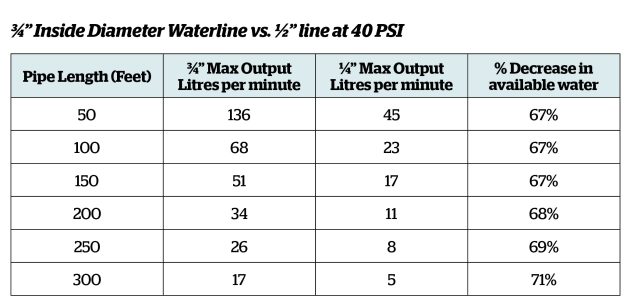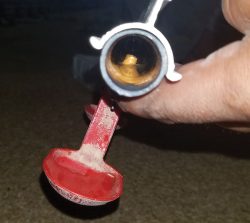
Maximizing waterline output
By Wade McDonough
Features Barn ManagementAre you unknowingly restricting water to your birds.
 The turns and restrictions in the plumbing of a water setup can restrict proper water flow to the birds.
PHOTO CREDIT: Proxy-Clean Products.
The turns and restrictions in the plumbing of a water setup can restrict proper water flow to the birds.
PHOTO CREDIT: Proxy-Clean Products. There’s plenty of talk about the quality of water we provide for our flocks. But how often do we investigate the volume of water our equipment is providing?
Just like every water source seems to have different attributes and variations, every water system also has its own set of variables. From the diameter of the incoming lines, to the number of 90-degree fittings plumbed into the system, to the length of the waterlines themselves, the setup of our watering system could be restricting the amount of water our birds are getting, especially at peak demand.

The chart above demonstrates the mathematical difference in litres per minute of water your system can provide based on the diameter and length of a waterline.
Pipe dimensions
Let’s take a look at how pipe diameter and length can decrease the output of the waterline.
A good place to start is the maximum output a waterline may provide in litres per minute. For example, if the inside diameter of the waterline is ¾” with a pressure of 40 psi, then a 50-foot waterline could produce 136 litres per minute of water. However, when you increase the length of the waterline to 250 feet, the maximum output drops to just 26 litres per minute.
Just increasing the length of the waterline from 50 feet to 250 feet results in an 81 per cent decrease in the maximum output of the line.
What would happen to this same line if a mineral or bacteria/algae buildup has choked down the inside of this line from 3/4” to 1/2”? Well, let’s compare!
The impact of buildup
The following is a comparison between a 3/4” inside diameter waterline and a 1/2” line.
Remember, the ¾” inside diameter waterline at 40 psi produces 136 litres per minute at 50 feet in length and roughly 26 litres per minute at 250 feet in length. A 50-foot long ½” line at the same pressure is going to reduce the maximum output to 45 litres per minute and at 250 feet the maximum output will decrease to only eight litres per minute. That is a significant decrease in water availability and all it takes is a 1/8” buildup of scale or biofilm all around the inside of the line to go from a ¾” diameter to a ½” diameter.
Go a little smaller with the diameter of your pipe and your maximum water output decreases dramatically.
Other challenges
While this can present significant challenges in providing enough water for our birds, many times we compound the problem ourselves.
What else are we doing that reduces the flow in our waterlines?

This waterline was caked in iron, restricting water flow to the birds.
Think about what your water system looks like. Every time we make a repair, add a new piece of equipment or perform anything plumbing related, we tend to put in elbows and T’s to give us more room or we reroute around problem areas. Each time we do this, we decrease the ability of our system to provide the maximum allowable output of water. Ninety-degree elbows, valves, fittings and bends all cause friction and turbulence – and sometimes cavitation (the formation of air bubbles in the line). These all act to reduce the water available to our birds.
Another important point to remember is that water availability to our birds is also affected by nipple drinker placement. Most manufacturers, professional organizations and primary breeders recommend no more than 10 birds per drinker for optimal performance.
An important question is are there enough drinkers on your line? Perhaps an even more important question is are all of your drinkers functioning properly?
What other problems may be hiding in our water systems? Filters, screens and regulators can also create significant water restrictions.
Focus on what you can control
We face many challenges in the operation of our poultry watering systems. Many of these challenges we cannot overcome. The length of our waterlines is a perfect example. We can’t change that.
However, we can control other aspects of our watering systems:
Minimize restrictions plumbed into the lines
Next time you plumb, think about if you really need a 90-degree fitting there. This might be a good chance to cleanup the plumbing and get a straight section put in.
Keep lines clean to maximize flow capacity
When was the last time you cleaned the waterlines with an oxidizer? Have you ever descaled them (this is different from cleaning with an oxidizer)?
Replace filters
To improve water flow, replace filters more often.
Install enough drinkers
Provide an adequate number of drinkers in relationship to the flock density.
The question posed at the beginning was, “Are you unknowingly restricting water to your birds”? Given all the hidden dangers identified above, I believe the answer is a resounding yes!
Wade McDonough is director of sales and marketing at Proxy-Clean Products.
Print this page